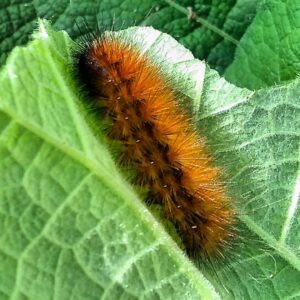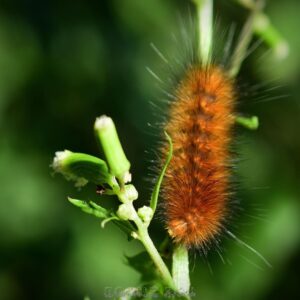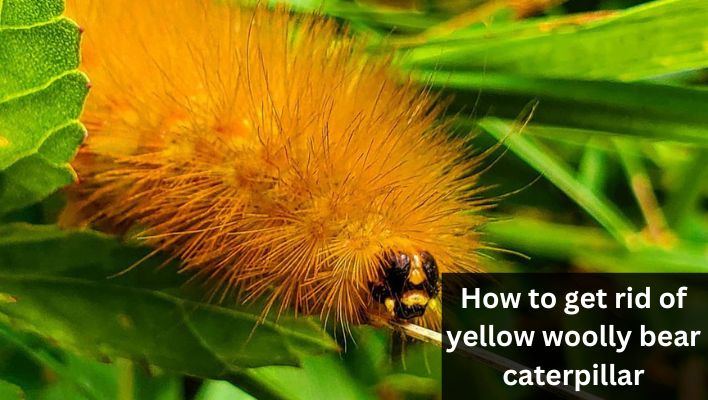Have you ever come across yellow woolly bear caterpillars in your garden or yard? These fuzzy little creatures may seem harmless, but they can wreak havoc on your plants and disrupt the natural balance of your outdoor space.
In this article, we’ll explore the world of yellow woolly bear caterpillars, their potential impact, and most importantly, how to effectively get rid of them.
Managing the presence of yellow woolly bear caterpillars is crucial for maintaining the health and beauty of your garden. By taking proactive measures, you can protect your plants and prevent further damage.
So, grab your gardening gloves, roll up your sleeves, and join us as we embark on a journey to reclaim your garden from the clutches of those yellow woolly bear caterpillars. Say goodbye to the nibbled leaves, the frustration, and the battles with nature.
Identifying Yellow Woolly Bear Caterpillars
When it comes to dealing with yellow woolly bear caterpillars, knowing your enemy is half the battle. These little critters may not look intimidating, but their insatiable appetite can wreak havoc on your plants.
Let’s dive into the details of how to identify these fuzzy intruders, where to find them, and how to distinguish them from other caterpillar species.
Appearance:
Yellow woolly bear caterpillars are quite distinctive in their appearance. They sport a dense covering of yellow or orange-yellow hairs that give them a woolly or fuzzy texture.
Their bodies are cylindrical, measuring about 1 to 1.5 inches in length, and feature black or dark brown bands at each end. The middle section between these bands is usually a paler yellow or white color.

Where to Find Them:
Yellow woolly bear caterpillars can be found in a variety of outdoor environments. They are often spotted crawling on plants, trees, and shrubs, where they indulge in their leaf-munching activities.
Keep an eye out for them in your garden, flower beds, vegetable patches, and even in natural habitats like meadows and woodlands.
Distinguishing from Other Caterpillars:
While yellow woolly bear caterpillars have their unique characteristics, it’s important to differentiate them from other caterpillar species to ensure accurate identification.
One key feature to note is their distinct woolly texture, which sets them apart from smooth-skinned caterpillars.
Additionally, their specific coloration, yellow or orange-yellow with black or dark brown bands—is a telltale sign that you’re dealing with yellow woolly bear caterpillars.
However, it’s worth noting that other caterpillars may resemble yellow woolly bears to some extent. For instance, the black and yellow woolly bear caterpillars (Isia isabella) have similar fuzziness but exhibit black and orange bands instead of black and yellow.
So, pay close attention to the color patterns and characteristics to accurately identify yellow woolly bear caterpillars in your garden.
Reasons to Control Yellow Woolly Bear Caterpillars
Yellow woolly bear caterpillars may appear harmless at first glance, but make no mistake, they can wreak havoc on your beloved plants and crops.
Let’s delve into the reasons why it’s crucial to control these fuzzy intruders and take proactive measures to minimize their impact.
Damage Caused by Caterpillars:
Yellow woolly bear caterpillars have voracious appetites, and their primary source of sustenance is the leaves of various plants.
As they munch their way through your garden, they can defoliate plants, leaving them weak, stressed, and vulnerable to diseases and other pests.
Prolonged feeding by a significant number of caterpillars can result in stunted growth, diminished flower production, and even plant death.
Signs of infestation
Yellow woolly bear caterpillar infestations can be identified through several signs. Here are some common indicators of their presence:
- Defoliation: If you notice extensive leaf damage on your plants, with large sections or entire leaves consumed, it could be a sign of a yellow woolly bear caterpillar infestation. These caterpillars have voracious appetites and can quickly defoliate plants.
- Chewed Leaves: Yellow woolly bear caterpillars have a distinct feeding pattern, leaving behind irregularly shaped holes or jagged edges on leaves. The extent and pattern of the leaf damage can provide clues to their presence.
- Presence of Frass: Frass refers to the droppings or excrement of the caterpillars. Look for small black or brown pellets on leaves, the ground around plants, or in the web-like structures they create for protection. The presence of frass can indicate an active infestation.
- Silk Webbing: When yellow woolly bear caterpillars feed in groups, they may create silk webbing or nests in the foliage. These webs can be found on the leaves undersides or branch crotches. The silk webbing provides them shelter and protection.
- Caterpillar Sightings: Spotting the yellow woolly bear caterpillars themselves is a sure sign of an infestation. These caterpillars have a distinct appearance, with yellow or orange bristles covering their black or dark brown bodies.
If you notice any of these signs in your garden, it’s important to take appropriate measures to control the infestation and protect your plants from further damage.

Potential Risks to Plants and Crops:
Beyond the visible damage to leaves, yellow woolly bear caterpillars can pose additional risks to your plants and crops.
When these caterpillars consume plant tissues, they can create wounds that serve as entry points for pathogens.
Fungal infections and bacterial diseases can take advantage of these openings, further compromising the health of your vegetation.
In agricultural settings, yellow woolly bear caterpillar infestations can be particularly detrimental. Farmers and gardeners depend on healthy crops for sustenance and livelihood.
If left unchecked, these caterpillars can significantly reduce crop yields, impacting food production and economic stability.
Importance of Early Intervention:
Early intervention is vital when it comes to managing yellow woolly bear caterpillars. By detecting their presence early on and taking action promptly, you can prevent the situation from spiraling out of control.
Monitoring your plants regularly, especially during their vulnerable growth stages, allows you to identify caterpillar infestations and initiate appropriate control measures before significant damage occurs.
Ways to Get Rid of Yellow Woolly Bear Caterpillars
Dealing with yellow woolly bear caterpillars requires a multi-pronged approach that combines preventive measures, mechanical control methods, and targeted interventions. Let’s explore various effective methods to eliminate these pesky pests and restore balance to your garden.
Bacillus thuringiensis (Bt) as a Targeted Treatment
One of the most widely recognized and targeted organic insecticides for caterpillar control is Bacillus thuringiensis, commonly known as Bt. This naturally occurring soil bacterium produces a toxin that specifically affects the digestive system of caterpillars, including yellow woolly bears.
Bt formulations can be applied as sprays, dust, or granules directly onto the foliage where caterpillars are present. Bt is highly effective against yellow woolly bear caterpillars during their early stages of development when they are actively feeding.
Once ingested, the toxin disrupts their ability to digest food, leading to starvation and death. Bt is safe for humans, pets, and beneficial insects, making it an excellent choice for targeted treatment.

Remove Caterpillar Habitats:
One of the first steps in controlling yellow woolly bear caterpillars is to eliminate their preferred habitats.
Inspect your garden and remove any debris, dead plant material, or piles of leaves where these caterpillars might seek shelter.
By reducing their hiding spots, you discourage their presence and make your garden less appealing to them.
Encourage Natural Predators:
Nature has its pest control system, and attracting natural predators of yellow woolly bear caterpillars can help keep their populations in check.
Encourage beneficial insects like ladybugs, lacewings, and parasitic wasps, which feed on caterpillars, by planting nectar-rich flowers and creating habitats such as bug hotels.
Birds, such as chickadees and wrens, also enjoy snacking on caterpillars, so providing bird feeders and birdhouses can invite these helpful allies to your garden.
Handpicking and Manual Removal:
When dealing with a manageable infestation, manually removing yellow woolly bear caterpillars can be effective.
Put on a pair of gloves and carefully pick them off your plants, placing them in a bucket of vinegar with water to ensure they won’t return.
Regularly inspect your plants and continue this method as needed to stay on top of the population.
Use Barriers and Traps:
Create physical barriers to protect vulnerable plants from yellow woolly bear caterpillars. Place floating row covers or netting over your garden beds to prevent them from accessing your plants.
Additionally, sticky traps or tree bands can be used to capture and immobilize the caterpillars as they crawl along branches or up plant stems.
Insecticides for Caterpillar Control
If the infestation becomes severe and other methods haven’t yielded satisfactory results, consider using insecticides specifically labeled for caterpillar control.
Choose products such as SUMMIT that are safe for the plants you’re treating and follow the instructions carefully. Remember to use insecticides sparingly and as a last resort, prioritizing eco-friendly alternatives.
Eco-friendly Alternatives:
For those seeking organic and environmentally friendly options, several natural remedies can deter and control yellow woolly bear caterpillars. Neem oil, derived from the neem tree, can act as a repellent and disrupt their growth and development.
Introduce Beneficial Nematodes:
Beneficial nematodes are microscopic roundworms that can help control caterpillar populations, including yellow woolly bear caterpillars. These nematodes seek out and infect caterpillar larvae, effectively reducing their numbers.
You can purchase nematodes specifically formulated for caterpillar control and apply them to your garden according to the instructions.

Companion Planting:
Utilize companion planting techniques to deter yellow woolly bear caterpillars. Some plants have natural compounds or scents that repel these pests.
For example, planting herbs like mint, rosemary, or thyme near susceptible plants can help deter caterpillars. Additionally, flowers such as marigolds, calendulas, and daisies can attract beneficial insects that prey on caterpillars.
Prune-Infested Branches:
If you notice yellow woolly bear caterpillars concentrated on specific branches or areas of your plants, pruning those infested branches can help contain the problem. Dispose of the pruned branches carefully to prevent the caterpillars from returning.
Apply Horticultural Oils:
Horticultural oils, such as insecticidal soaps or dormant oils, can be used to smother and suffocate yellow woolly bear caterpillars. Apply these oils according to the product instructions, focusing on the areas where the caterpillars are present.
Use Homemade Remedies:
DIY solutions like a mixture of dish soap and water or a solution of cayenne pepper and water can be sprayed directly on yellow woolly bear caterpillars to deter them from feeding on your plants. Test these remedies on a small area first to ensure they won’t damage your plants.
Practice Crop Rotation:
If you’re dealing with yellow woolly bear caterpillars in your vegetable garden, practicing crop rotation can help disrupt their life cycle. By moving susceptible plants to different areas each year, you make it harder for the caterpillars to find their preferred food sources.
Diatomaceous Earth:
Diatomaceous earth is a fine powder made from the fossilized remains of marine organisms. It contains sharp microscopic particles that pierce the exoskeletons of insects, including caterpillars.
Sprinkle diatomaceous earth around the base of plants or directly on the leaves to create a barrier that deters yellow woolly bear caterpillars.
Preventive Measures to Discourage Yellow Woolly Bear Caterpillars
Prevention is always better than dealing with an infestation. By implementing a few simple measures, you can create an environment that is less inviting to yellow woolly bear caterpillars. Here are some preventive measures to discourage their presence in your garden:
- Clean and Tidy Garden Beds: Maintain a clean and tidy garden by regularly removing fallen leaves, plant debris, and weeds. These provide hiding spots and potential food sources for yellow woolly bear caterpillars. Keeping your garden beds free from clutter reduces their opportunities for survival and reproduction.
- Proper Plant Spacing: When planting in your garden, ensure adequate spacing between plants. Crowded plants create an environment that favors the spread of pests, including yellow woolly bear caterpillars. Sufficient airflow and sunlight around each plant help to discourage infestations and promote overall plant health.
- Monitor Plants Regularly: Be diligent in inspecting your plants regularly. Look for signs of yellow woolly bear caterpillar activity, such as chewed leaves, droppings (frass), or clusters of eggs. Early detection allows you to take swift action and prevent the caterpillars from causing significant damage.
- Encourage Beneficial Insects: Attract beneficial insects to your garden, as they can help control yellow woolly bear caterpillar populations naturally. Plant nectar-rich flowers, such as daisies, sunflowers, and coneflowers, to attract beneficial insects like ladybugs, lacewings, and parasitic wasps. These insects prey on caterpillars and help maintain a balanced ecosystem.
- Companion Planting: Utilize companion planting techniques to repel yellow woolly bear caterpillars. Certain plants, such as garlic, onions, chives, and mint, are known to have natural insect-repellent properties. Interplanting these repellent plants alongside susceptible crops or ornamentals can help deter caterpillars from feasting on your plants.
- Use Row Covers or Netting: Cover vulnerable plants with floating row covers or fine mesh netting to physically block yellow woolly bear caterpillars from accessing them. These covers act as a barrier, preventing the caterpillars from laying eggs or feeding on the foliage. Ensure the covers are secured tightly to prevent any gaps.
- Practice Crop Rotation: Rotate your crops annually to disrupt the life cycle of yellow woolly bear caterpillars. By planting susceptible plants in different locations each year, you make it more challenging for the caterpillars to find their preferred food sources. This reduces the risk of recurring infestations.
- Natural Repellents: Explore the use of natural repellents to deter yellow woolly bear caterpillars. Sprinkle diatomaceous earth, neem oil, or other horticultural oils around the base of your plants. These substances create a barrier that the caterpillars dislike and help to discourage them from crawling up and feeding on the foliage.
By incorporating these preventive measures into your gardening routine, you can create an environment that is less attractive to yellow woolly bear caterpillars.
By deterring their presence, you can reduce the chances of infestations and ensure healthier plants in your garden.
Stay vigilant and take action promptly if you notice any signs of caterpillar activity. Prevention is key to maintaining a thriving garden ecosystem.

Get Rid of Yellow Woolly Bear Caterpillar FAQs
How long does the yellow woolly bear caterpillar stage last
The duration of the yellow woolly bear caterpillar stage can vary depending on environmental conditions and food availability. Generally, this stage lasts for several weeks to a few months.
The caterpillars go through several molts, shedding their skin as they grow. Each molt represents a new instar, and they typically have six instars before entering the pupal stage to undergo metamorphosis and transform into adult moths.
Are yellow woolly bear caterpillars poisonous to humans?
No, yellow woolly bear caterpillars are not poisonous to humans. They do not possess venom or produce toxins that can harm humans.
However, it’s important to note that some individuals may have an allergic reaction if they come into contact with the caterpillar’s bristly hair.
These hairs can cause skin irritation, redness, or itching. It’s best to avoid direct contact with yellow woolly bear caterpillars to prevent any potential allergic reactions.
What plants do yellow woolly bear caterpillars prefer?
Yellow woolly bear caterpillars are known to feed on a variety of plants, but they have a preference for certain species.
Common plants that yellow woolly bear caterpillars are attracted to include asters, sunflowers, daisies, clover, lettuce, and various garden vegetables such as cabbage, broccoli, and kale.
However, it’s important to note that they can also feed on other plants if their preferred choices are not available.
Can I use chemical insecticides to control these caterpillars?
While chemical insecticides can be effective in controlling yellow woolly bear caterpillars, it’s important to consider the potential drawbacks.
Chemical insecticides may harm beneficial insects, such as bees and butterflies, and can have adverse effects on the environment.
Additionally, prolonged use of chemical insecticides can lead to the development of resistance in caterpillars and other pests.
Therefore, it is recommended to explore organic and environmentally friendly control methods, such as those mentioned earlier, before resorting to chemical insecticides.
Conclusion
Dealing with yellow woolly bear caterpillars in your garden can be a challenging task, but with the right knowledge and strategies, you can effectively manage their presence.
Throughout this article, we have explored various aspects of getting rid of yellow woolly bear caterpillars, from identifying their appearance and habitat to understanding the reasons for their control.
We have discussed a range of effective methods to combat them, including physical removal, organic insecticides, natural repellents, and preventive measures.
It is essential to be proactive in your approach and stay vigilant in monitoring your plants for any signs of yellow woolly bear caterpillar activity.
Early detection and intervention can prevent significant damage to your plants and minimize the need for extensive control measures.
Remember, prevention is always better than cure, so implementing gardening practices that discourage their infestation is crucial.
Furthermore, it is advisable to prioritize organic and environmentally friendly methods of control, as they not only target the caterpillars but also safeguard beneficial insects, minimize harm to the ecosystem, and promote sustainable gardening practices.
By utilizing these methods, such as biological control, companion planting, and encouraging natural predators, you can maintain a balanced and harmonious garden environment.
Successfully getting rid of yellow woolly bear caterpillars requires a combination of knowledge, action, and persistence.
By following the techniques and recommendations outlined in this article, you are equipped with the tools to protect your plants from these voracious caterpillars and create a thriving garden ecosystem.
